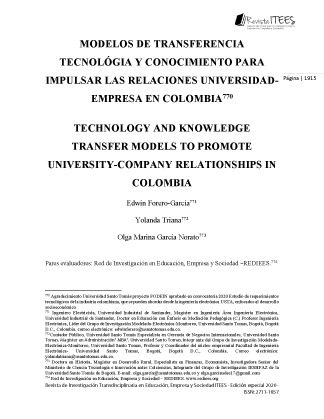XCIX. TECHNOLOGY AND KNOWLEDGE TRANSFER MODELS TO PROMOTE UNIVERSITY-COMPANY RELATIONSHIPS IN COLOMBIA
##plugins.themes.bootstrap3.article.main##
Abstract
Engineering programs work to have education processes that efficiently meet the needs of
society, the state, and industry. Electronic engineering is one of the disciplines called upon
to contribute new knowledge that contributes to answering questions that have not yet been
answered in academia or science, to overcome technological development problems in the
country and in the world. For this reason, it is pertinent to know what the technological
requirements of the industry are, not only in terms of the formation of human capacities, but
also in the possibilities it provides in innovation and development to achieve the social
appropriation of knowledge, through the application in real cases of companies, to promote
dialogue between academia, state and industry and provide strategies for national and
international development.
The results presented in this article include models of technology transfer and knowledge
evidenced in the theory and practice found in a judicious review of the state of the art and
the experiences found in this application. Likewise, the description of the common elements
in a transfer process and the interaction between the levels involved are indicated, through
the presentation of a proposed model concept for the transfer of technologies and knowledge
in the relational context between university, state, and industry.
Download Statistics
##plugins.themes.bootstrap3.article.details##
electronic engineering, knowledge, technology transfer, university, industry
revistas.urosario.edu.co. Retrieved September 14, 2020, from
https://revistas.urosario.edu.co/index.php/empresa/article/view/1087
Caicedo Asprilla, H. (2012). An approach to identifying, measuring, and generating
reciprocal spillovers. Cuadernos de Administración (Universidad Del Valle), 28(48),
104–116. http://www.scielo.org.co/scielo.php?script=sci_arttext&pid=S0120-
46452012000200009&lng=en&nrm=iso&tlng=es
Cristóbal, R. V. (n.d.). Crecimiento endógeno en un país menos desarrollado: el caso de
firmas imitadoras.
De Ossa, M. T., Londoño, J. E., & Valencia-Arias, A. (2018). Modelo de Transferencia
Tecnológica desde la Ingeniería Biomédica: un estudio de caso. Información
Tecnológica, 29. https://doi.org/10.4067/S0718-07642018000100083
Estadísticas PI | Superintendencia de Industria y Comercio. (n.d.). Retrieved September 9,
2020, from https://www.sic.gov.co/estadisticas-propiedad-industrial
Grosse, R., & Grosse, R. (1996). international Technology Transfer in Services. Journal of
International Business Studies, 27, 782.
http://www.jstor.org.leo.lib.unomaha.edu/stable/pdfplus/155512.pdf?acceptTC=true
&jpdConfirm=true
Guía Técnica para el Reconocimiento de Oficinas de Transferencia de Resultados de
Investigación-Otri. (n.d.). Retrieved September 15, 2020, from
http://www.colciencias.gov.co/COLCIENCIAS/sistema-gestion-calidad
Jiménez, C.-N., & Castellanos, O. (2011). El Valor de la Tecnología: Enfoques Novedosos
para su Determinación The Value of Technology: Novel Approaches for its
Estimation. In J. Technol. Manag. Innov (Vol. 8). http://www.jotmi.org
K. Ramanathan. (n.d.). An Overview of Technology Transfer and Technology Transfer
Models.
Lee, S., & Shvetsova, O. A. (2019). Optimization of the Technology Transfer Process Using
Gantt Charts and Critical Path Analysis Flow Diagrams: Case Study of the Korean
Automobile Industry. Processes, 7(12). https://doi.org/10.3390/pr7120917
López, C. G., del Socorro, M., & Carlos, J. (2006). Panorama Socioeconómico. Diferentes
Manifestaciones Panorama Socioeconómico, 24, 70–81.
http://www.redalyc.org/articulo.oa?id=39903208
Main Science and Technology Indicators - OECD. (n.d.). Retrieved September 9, 2020, from
http://www.oecd.org/science/inno/msti.htm
Sagar Pagar, A. K. P. P. M. G. and S. J. (n.d.). Review Article On Technology Transfer.
Retrieved September 15, 2020, from http://www.ijpab.com/form/2014 Volume 2,
issue 3/IJPAB-2014-2-3-145-153.pdf
Seúl, L. K.-, Korea, E. U. de, & 2001, undefined. (n.d.). La dinámica del aprendizaje
tecnológico en la industrialización. In oei.es. Retrieved September 14, 2020, from
https://www.oei.es/historico/salactsi/limsu.pdf
Sharif, M., & Haq, A. (1980). A time-level model of technology transfer. IEEE Transactions
on Engineering Management, EM-27, 49–58.
Steenhuis, H.-J., & Bruijn, E. (2005). International Technology Transfer: Building Theory
from Multiple Case-study in the Aircraft Industry.
Transferencia de conocimiento y tecnología | Minciencias. (n.d.). Retrieved September 15,
2020, from
https://minciencias.gov.co/viceministerios/conocimiento/direccion_transferencia/tra
nsferencia-conocimiento
Velásquez, S. M., Viana, N. E., Franco, F. J., & Pino, A. A. (2019). Model of Technology
and Knowledge Transfer of the Center for Enterprise Services and Management: A
Case Study. Entre Ciencia e Ingeniería, 13(25), 100–106.
https://doi.org/10.31908/19098367.4020
Whitford, O. R. A. (n.d.). Instituto Tecnológico De Costa Rica Informe Final De Trabajo De
Investigacion Presentado A La Vicerrectoria De Investigación Y Extensión Del
Instituto Tecnologico De Costa Rica Transferencia Tecnologica Y Creacion De Spin
Offs.





